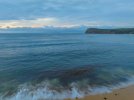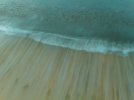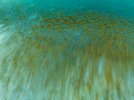retiredNH
Well-Known Member
But the extent of the blur vs time is also influenced by focal length.
Regardless, just experiment.
Regardless, just experiment.
Huh? A photographic "stop" is defined as a doubling or halving of light. From 1/100, a stop down is 1/50. Two stops is 1/25 and we get to 1/12.5 (call it 1/10) at just 3 stops. Maybe ND filters use some other terminology...but...nah. 3 stops down from 1/100 would, for photographers, already be at roughly 1/10. If you meant to start at 1/1000 and not 100 it would still only take 6 2/3 stops to get to 1/10. Most ND filter sets are sold as 4/8/16 or 8/16/32 in that range with the idea that the goal is most commonly to change the shutter speed one or two stops to provide a shutter speed that is twice the frame rate. That doesn't take too much. If your auto shutter speed is 1/1000 and you are shooting at 4k/60 (very common) then you are looking for a shutter of 1/125 which requires an ND8 filter. To shoot a waterfall at 1/4 you will need an ND 256! Thus, I see ND filters in two categories. Those needed for matching shutter speed to frame rate....ND 8-32 typically, and those needed for water and hyperlapses that also benefit from a long shutter to blur cars and such. Those ND filter needs can go up to 1000 or even 2000 in some situations. I'm just now getting an order in for my Avata. Just the typical ND range for an upcoming desert flying vacation...that I am now going to post some questions about! Hope I have given correct information. A few years ago I made a mistake and it could happen again so if I'm off on this, just let me know and I'll buy you coffee next time you're in North Pole...For beach/rock waves, a simple rule of thumb I keep in mind that a 10-stop ND filter (an ND1000) would darken a 1/100s scene down to a 10s exposure.
10 stops down from 1/100 is ~10 seconds, just as WookiePilot stated, so I’m not sure what you’re trying to say.Huh? A photographic "stop" is defined as a doubling or halving of light. From 1/100, a stop down is 1/50. Two stops is 1/25 and we get to 1/12.5 (call it 1/10) at just 3 stops. Maybe ND filters use some other terminology...but...nah. 3 stops down from 1/100 would, for photographers, already be at roughly 1/10. If you meant to start at 1/1000 and not 100 it would still only take 6 2/3 stops to get to 1/10. Most ND filter sets are sold as 4/8/16 or 8/16/32 in that range with the idea that the goal is most commonly to change the shutter speed one or two stops to provide a shutter speed that is twice the frame rate. That doesn't take too much. If your auto shutter speed is 1/1000 and you are shooting at 4k/60 (very common) then you are looking for a shutter of 1/125 which requires an ND8 filter. To shoot a waterfall at 1/4 you will need an ND 256! Thus, I see ND filters in two categories. Those needed for matching shutter speed to frame rate....ND 8-32 typically, and those needed for water and hyperlapses that also benefit from a long shutter to blur cars and such. Those ND filter needs can go up to 1000 or even 2000 in some situations. I'm just now getting an order in for my Avata. Just the typical ND range for an upcoming desert flying vacation...that I am now going to post some questions about! Hope I have given correct information. A few years ago I made a mistake and it could happen again so if I'm off on this, just let me know and I'll buy you coffee next time you're in North Pole....
ND filter chart



Nice shots!I took these ones a couple of days ago with the Mavic 3, a bit of fun with the seaweed on the shore break.
I do a lot of sunrise photography and depending on the light I adjust the exposure settings first then as it gets lighter I can add an ND filter to slow down the water and stop blowouts in the sky.
Mavic 3: 0.5 sec ISO 100 f/11 and ND 4
Mavic 3: 2 sec ISO 100 f/11 and ND 4
Mavic 3: 1.3 sec ISO 100 f/11 and ND 4
Each stop is as you say a doubling or halving of light.Huh? A photographic "stop" is defined as a doubling or halving of light. From 1/100, a stop down is 1/50. Two stops is 1/25 and we get to 1/12.5 (call it 1/10) at just 3 stops. Maybe ND filters use some other terminology...but...nah. 3 stops down from 1/100 would, for photographers, already be at roughly 1/10. If you meant to start at 1/1000 and not 100 it would still only take 6 2/3 stops to get to 1/10. Most ND filter sets are sold as 4/8/16 or 8/16/32 in that range with the idea that the goal is most commonly to change the shutter speed one or two stops to provide a shutter speed that is twice the frame rate. That doesn't take too much. If your auto shutter speed is 1/1000 and you are shooting at 4k/60 (very common) then you are looking for a shutter of 1/125 which requires an ND8 filter. To shoot a waterfall at 1/4 you will need an ND 256! Thus, I see ND filters in two categories. Those needed for matching shutter speed to frame rate....ND 8-32 typically, and those needed for water and hyperlapses that also benefit from a long shutter to blur cars and such. Those ND filter needs can go up to 1000 or even 2000 in some situations. I'm just now getting an order in for my Avata. Just the typical ND range for an upcoming desert flying vacation...that I am now going to post some questions about! Hope I have given correct information. A few years ago I made a mistake and it could happen again so if I'm off on this, just let me know and I'll buy you coffee next time you're in North Pole....
ND filter chart
Entirely my bad. I read 10s as 1/10th sec probably because I never think in terms of 10sec with any drone video or still imaging. My bad.Huh? A photographic "stop" is defined as a doubling or halving of light. From 1/100, a stop down is 1/50. Two stops is 1/25 and we get to 1/12.5 (call it 1/10) at just 3 stops. Maybe ND filters use some other terminology...but...nah. 3 stops down from 1/100 would, for photographers, already be at roughly 1/10. If you meant to start at 1/1000 and not 100 it would still only take 6 2/3 stops to get to 1/10. Most ND filter sets are sold as 4/8/16 or 8/16/32 in that range with the idea that the goal is most commonly to change the shutter speed one or two stops to provide a shutter speed that is twice the frame rate. That doesn't take too much. If your auto shutter speed is 1/1000 and you are shooting at 4k/60 (very common) then you are looking for a shutter of 1/125 which requires an ND8 filter. To shoot a waterfall at 1/4 you will need an ND 256! Thus, I see ND filters in two categories. Those needed for matching shutter speed to frame rate....ND 8-32 typically, and those needed for water and hyperlapses that also benefit from a long shutter to blur cars and such. Those ND filter needs can go up to 1000 or even 2000 in some situations. I'm just now getting an order in for my Avata. Just the typical ND range for an upcoming desert flying vacation...that I am now going to post some questions about! Hope I have given correct information. A few years ago I made a mistake and it could happen again so if I'm off on this, just let me know and I'll buy you coffee next time you're in North Pole....
ND filter chart
Hey-Tough Guy.What about the optical density scale?Each stop is as you say a doubling or halving of light.
So a 10-stop filter (or "ND1000") is a 1024 (2^10) change in light levels. But the numbers do get rounded a bit.
1/100 * 1000 == 10.
0: 1/100
1: 1/50
2: 1/25
3: 1/13
4: 1/6
5: 1/3
6: 1/2
7: 1.3"
8: 2.5"
9: 5"
10: 10"
Don't get me started on the "optical density" scale (where ND1000 == 3.0)...
It's a logarithmic scale. Yet ANOTHER way of referring to filters. It can make sense in some situations, but 3 ways of specifying density is at least one too many in my mind.Hey-Tough Guy.What about the optical density scale?

wonderful imagesSome great examples of water blur with a 2S in this post: Air 2s - Autumn in Virginia and West Virginia
We use essential cookies to make this site work, and optional cookies to enhance your experience.

